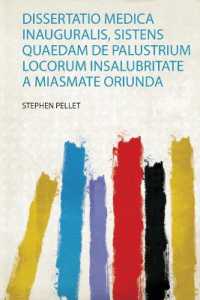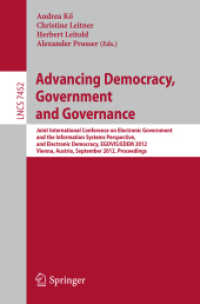Full Description
The best of the "product" and "process" approaches to writing.The Longman Writer with MyWritingLab draws on decades of teaching experience to integrate the best of the "product" and "process" approaches to writing. Emphasis on the reading-writing connection, focus on invention and revision, and attention to the fact that patterns blend in actual writing are delivered with clear, step-by-step writing instruction and extensive practice activities and assignments-more than 500 in all.Teaching and Learning Experience This program will provide a better teaching and learning experience for you and your students.* Robust resources improve students' writing and allow instructors to track results. WithinMyWritingLab, students can measure how well they understand key concepts while faculty can incorporate rubrics into meaningful assignments, grade based on desired criteria, and analyze class performance through advanced reporting. * Emphasis on Process. Each project chapter in Part III instructs students how to write using a specific rhetorical strategy by working through each stage of the writing process. Each of these stages is also covered in its own standalone chapter in Part II for additional information and reinforcement.* Emphasis on Practice. Each project chapter in Part III contains reading comprehension questions; rhetorical analysis questions; prewriting activities; revision activities; general assignments; assignments with a specific purpose, audience, and point of view-and more. * Emphasis on Combining Rhetorical Patterns. Each project chapter in Part III contains not only writing assignments using one rhetorical strategy in a paper but also writing assignments that encourage students to combine several patterns in their paper.
Contents
Preface xvPart IThe Reading Process1 Becoming a Critical Reader Stage 1: Get an Overview of the Selection Stage 2: Deepen Your Sense of the Selection Stage 3: Evaluate the Selection Assessing Visuals in a Reading Assessing an Image: An Example Assessing a Graph: An Example A Model Annotated Reading Ellen Goodman, "Family Counterculture" Part IIThe Writing Process2 Getting Started Through Prewriting Use Prewriting to Get Started Keep a Journal The Pre-Reading Journal Entry Understand the Boundaries of the Assignment Determine Your Purpose, Audience, Tone, and Point of View Discover Your Essay's Limited Subject Generate Raw Material About Your Limited Subject Conduct Research Organize the Raw Material Activities: Getting Started Through Prewriting 3 Identifying a Thesis What Is a Thesis? Finding a Thesis Writing an Effective Thesis Tone and Point of View Implied Pattern of Development Including a Plan of Development 1. Don't Write a Highly Opinionated Statement 2. Don't Make an Announcement 3. Don't Make a Factual Statement 4. Don't Make a Broad Statement Arriving at an Effective Thesis Placing the Thesis in an Essay Activities: Identifying a Thesis 4 Supporting the Thesis with Evidence What Is Evidence? How Do You Find Evidence? How the Patterns of Development Help Generate Evidence Characteristics of Evidence The Evidence Is Relevant and Unified The Evidence Is Specific The Evidence Is Adequate The Evidence Is Dramatic The Evidence Is Accurate The Evidence Is Representative Borrowed Evidence Is Documented Activities: Supporting the Thesis with Evidence 5 Organizing the Evidence Use the Patterns of Development Select an Organizational Approach Chronological Approach Spatial Approach Emphatic Approach Simple-to-Complex Approach Prepare an Outline Activities: Organizing the Evidence 6 Writing the Paragraphs in the First Draft How to Move from Outline to First Draft General Suggestions on How to Proceed If You Get Bogged Down A Suggested Sequence for Writing the First Draft 1. Write the Supporting Paragraphs 2. Write Other Paragraphs in the Essay's Body 3. Write the Introduction 4. Write the Conclusion5. Write the Title Pulling It All Together Sample First Draft Harriet Davids, "Challenges for Today's Parents" Commentary Activities: Writing the Paragraphs in the First Draft 7 R evising Overall Meaning, Structure, and Paragraph Development Five Strategies to Make Revision Easier Set Your First Draft Aside for a While Work from Printed Text Read the Draft Aloud View Revision as a Series of Steps Evaluate and Respond to Instructor Feedback Peer Review: An Additional Revision Strategy Evaluate and Respond to Peer Review Revising Overall Meaning and Structure Revising Paragraph Development Sample Student Revision of Overall Meaning, Structure, and Paragraph Development Activities: Revising Overall Meaning, Structure, and Paragraph Development 8 Revising Sentences and Words Revising Sentences Make Sentences Consistent with Your Tone Make Sentences Economical Vary Sentence Type Vary Sentence Length Make Sentences Emphatic Revising Words 1Make Words Consistent with Your Tone Use an Appropriate Level of Diction Avoid Words That Overstate or Understate Select Words with Appropriate Connotations Use Specific Rather Than General Words Use Strong Verbs Delete Unnecessary Adverbs Use Original Figures of Speech Avoid Sexist Language Sample Student Revision of Sentences and Words Activities: Revising Sentences and Words 9 Editing and Proofreading Edit Carefully Use the Appropriate Manuscript Format Proofread Closely Student Essay: From Prewriting Through Proofreading Harriet Davids, "Challenges for Today's Parents" Commentary Activities: Editing and Proofreading Part IIIThe Patterns of Development10 Description What Is Description? How Description Fits Your Purpose and Audience Prewriting Strategies Strategies for Using Description in an Essay Revision Strategies Student Essay: From Prewriting Through Revision Marie Martinez, "Salt Marsh" Commentary Activities: Description Prewriting Activities Revising Activities Professional Selections: Description Mario Suarez, "El Hoyo" Cherokee Paul McDonald, "A View from the Bridge" Gordon Parks, "Flavio's Home" Additional Writing Topics: Description 11 Narration What Is Narration? How Narration Fits Your Purpose and Audience Prewriting Strategies Strategies for Using Narration in an Essay Revision Strategies Student Essay: From Prewriting Through Revision Paul Monahan, "If Only" Commentary Activities: Narration Prewriting Activities Revising Activities Professional Selections: Narration Audre Lorde, "The Fourth of July" Lynda Barry, "The Sanctuary of School" Joan Murray, "Someone's Mother" Additional Writing Topics: Narration 12 Illustration What Is Illustration? How Illustration Fits Your Purpose and Audience Prewriting Strategies Strategies for Using Illustration in an Essay Revision Strategies Student Essay: From Prewriting Through Revision Michael Pagano, "Pursuit of Possessions" Commentary Activities: Illustration Prewriting Activities Revising Activities Professional Selections: Illustration Kay S. Hymowitz, "Tweens: Ten Going On Sixteen" Beth Johnson, "Bombs Bursting in Air" France Borel, "The Decorated Body" Additional Writing Topics: Illustration 13 Division-Classification What Is Division-Classification? How Division-Classification Fits Your Purpose and Audience Prewriting Strategies Strategies for Using Division-Classification in an Essay Revision Strategies Student Essay: From Prewriting Through Revision Gail Oremland, "The Truth About College Teachers" Commentary Activities: Division-Classification Prewriting Activities Revising Activities Professional Selections: Division-Classification Ann McClintock, "Propaganda Techniques in Today's Advertising" Scott Russell Sanders, "The Men We Carry in Our Minds" Bianca Bosker, "How Teens Are Really Using Facebook: It's a `Social Burden,' Pew Study Finds" Additional Writing Topics: Division-Classification 14 Process Analysis What Is Process Analysis? How Process Analysis Fits Your Purpose and Audience Prewriting Strategies Strategies for Using Process Analysis in an Essay Revision Strategies Student Essay: From Prewriting Through Revision Robert Barry, "Becoming a Recordoholic" Commentary Activities: Process Analysis Prewriting Activities Revising Activities Professional Selections: Process Analysis Amy Sutherland, "What Shamu Taught Me About a Happy Marriage" David Shipley, "Talk About Editing" Alex Horton, "On Getting By" Additional Writing Topics: Process Analysis 15 Comparison-Contrast What Is Comparison-Contrast? How Comparison-Contrast Fits Your Purpose and Audience Prewriting Strategies Strategies for Using Comparison-Contrast in an Essay Revision Strategies Student Essay: From Prewriting Through Revision Carol Siskin, "The Virtues of Growing Older" Commentary Activities: Comparison-Contrast Prewriting Activities Revising Activities Professional Selections: Comparison-Contrast Eric Weiner, "Euromail and Amerimail" Patricia Cohen, "Reality TV: Surprising Throwback to the Past?" Alex Wright, "Friending, Ancient or Otherwise" Additional Writing Topics: Comparison-Contrast 16 Cause-Effect What Is Cause-Effect? How Cause-Effect Fits Your Purpose and Audience Prewriting Strategies Strategies for Using Cause-Effect in an Essay Revision Strategies Student Essay: From Prewriting Through Revision Carl Novack, "Americans and Food" Commentary Activities: Cause-Effect Prewriting Activities Revising Activities Professional Selections: Cause-Effect Stephen King, "Why We Crave Horror Movies" Belinda Luscombe, "The Science of Romance: Why We Flirt" Josie Appleton, "The Body Piercing Project" Additional Writing Topics: Cause-Effect 17 Definition What Is Definition? How Definition Fits Your Purpose and Audience Prewriting Strategies Strategies for Using Definition in an Essay Revision Strategies Student Essay: From Prewriting Through Revision Laura Chen, "Physics in Everyday Life" Commentary Activities: Definition Prewriting Activities Revising Activities Professional Selections: Definition Ann Hulbert, "Beyond the Pleasure Principle" Laura Fraser, "The Inner Corset" Keith Johnson, "Who's a Pirate? In Court, a Duel over Definitions" Additional Writing Topics: Definition 18 Argumentation-Persuasion What Is Argumentation-Persuasion? How Argumentation-Persuasion Fits Your Purpose and Audience Prewriting Strategies Strategies for Using Argumentation-Persuasion in an Essay Revision Strategies Student Essay: From Prewriting Through Revision Mark Simmons, "Compulsory National Service" Commentary Activities: Argumentation-Persuasion Prewriting Activities Revising Activities Professional Selections: Argumentation-Persuasion Anna Quindlen, "Driving to the Funeral" Mary Sherry, "In Praise of the "F" Word" Debating the Issues: Gender-Based Education Gerry Garibaldi, "How the Schools Shortchange Boys" Michael Kimmel, "A War Against Boys?" Debating the Issues: Government Regulation to Help Control Obesity and Related DiseasesRobert Lustig, Laura Schmidt, and Claire Brindis, "The Toxic Truth About Sugar" Michael Marlow and Sherzod Abdukadirov, "Government Intervention Will Not Solve Our Obesity Problem"Additional Writing Topics: Argumentation-PersuasionPart IVThe Research Essay19 Locating, Evaluating, Analyzing, and Synthesizing Research Sources Plan the Research Understand the Essay's Boundaries Choose a General Subject Prewrite to Limit the General Subject Understand Primary versus Secondary Research Conduct Preliminary Research Identify a Tentative (Working) Thesis Make a Schedule Conduct Primary Research Conduct Interviews Carry Out Surveys Conduct Secondary Research Find Books on Your Subject Find Periodicals on Your Subject Find Sources on the Internet Know the Advantages and Limitations of the Library and the Web Prepare a Working Bibliography and Take Notes Record Information About the Source Take Notes on the Source Evaluate Sources and Analyze Information Evaluate Sources Analyze Information Use Quotation, Summary, and Paraphrase to Synthesize Research While Avoiding Plagiarism Plagiarism Direct Quotation Summary Paraphrase Activities: Locating, Evaluating, and Integrating Research Sources 20 Writing the Research Essay Refine Your Working Thesis Sort Your Research Results Organize the Evidence by Outlining Write the First Draft Integrate Sources into Your Writing Using Sources Effectively Awkward Use of a Quotation Effective Use of a Source Introducing a Source Using Variety in Attributions Shortening or Clarifying Quotations Capitalizing and Punctuating Short Quotations Document Sources to Avoid Plagiarism What Needs to Be Documented? What Does Not Need to Be Documented? Creating In-Text References: MLA Format Revise, Edit, and Proofread the First Draft Prepare the Works Cited List: MLA Format General Instructions for the MLA Works Cited Citing Print Sources-Periodicals Citing Print Sources-Books Citing Sources Found on a Website Citing Sources Found Through an Online Database or Scholarly Project Citing Other Common Sources Prepare the References List: APA Format Parenthetic Citations in the Text General Instructions for the APA References ListCiting Print Sources-Periodicals Citing Print Sources-Books Citing Sources Found on a Website Citing Sources Found Through an Online Database or Scholarly Project Citing Other Common Sources Student Research Paper: MLA-Style Documentation Commentary Student Research Paper: APA-Style Documentation Activities: Writing the Research Essay Part VThe Literary Essay and Exam Essay21 Writing About Literature Elements of Literary Works Literary Terms How to Read a Literary Work Read to Form a General Impression Ask Questions About the Work Reread and Annotate Modify Your Annotations Write the Literary Analysis Prewrite Identify Your Thesis Support the Thesis with Evidence Organize the Evidence Write the First Draft Revise Overall Meaning, Structure, and Paragraph Development Edit and Proofread Pulling It All TogetherRead to Form a General Impression Langston Hughes, "Early Autumn" Student Essay Karen Vais, "Stopping to Talk" Commentary Additional Selections and Writing Assignments Robert Frost, "Out, Out-" Kate Chopin, "The Story of an Hour" 22 Writing Exam Essays Three Forms of Written Answers Short Answers Paragraph-Length Answers Essay-Length Answers How to Prepare for Exam Essays At the Examination Survey the Entire Test Understand the Essay Question Write the Essay Prewrite Identify Your Thesis Support the Thesis with Evidence Organize the Evidence Write the Draft Revise, Edit, and Proofread Sample Essay Answer CommentaryActivity: Writing Exam Essays Part VIA Concise HandbookSentence Faults Fragments Phrase Fragments Dependent Clause Fragments Comma Splices and Run-On Sentences Three Common Pitfalls Faulty Parallelism Verbs Problems with Subject-Verb Agreement How to Correct Faulty Subject-Verb Agreement Problems with Verb Tense How to Correct Inappropriate Shifts in Verb Tense How to Correct Faulty Use of Past Tense Pronouns Problems with Pronoun Use Pronoun Case How to Correct Faulty Pronoun Case Pronoun Agreement Pronoun Reference Modifiers Problems with ModificationMisplaced and Ambiguous Modifiers Dangling Modifiers Punctuation Period Question Mark Exclamation Point Comma SemicolonColon Quotation Marks Ellipsis Apostrophe Parentheses Brackets Hyphen Dash Mechanics Capitalization Italics Numbers Abbreviations SpellingNER(01): AU








